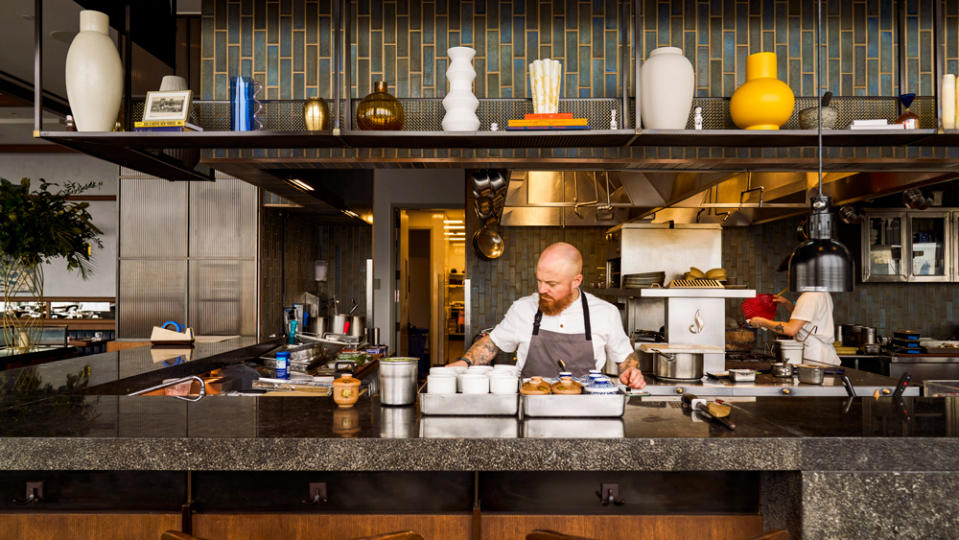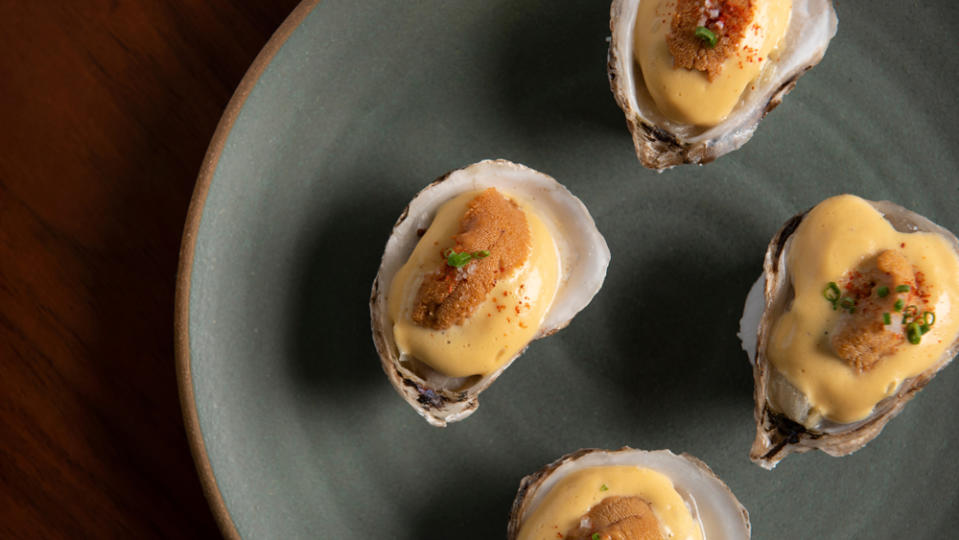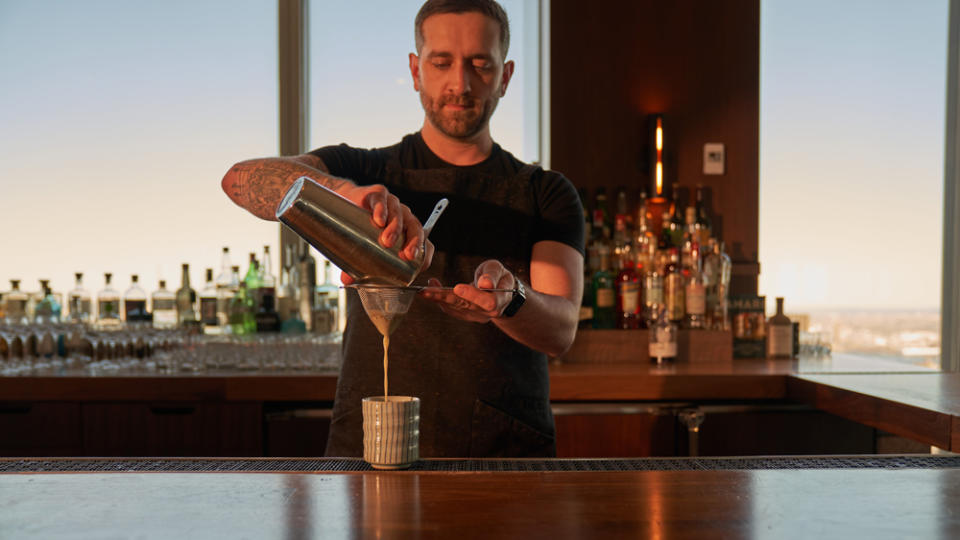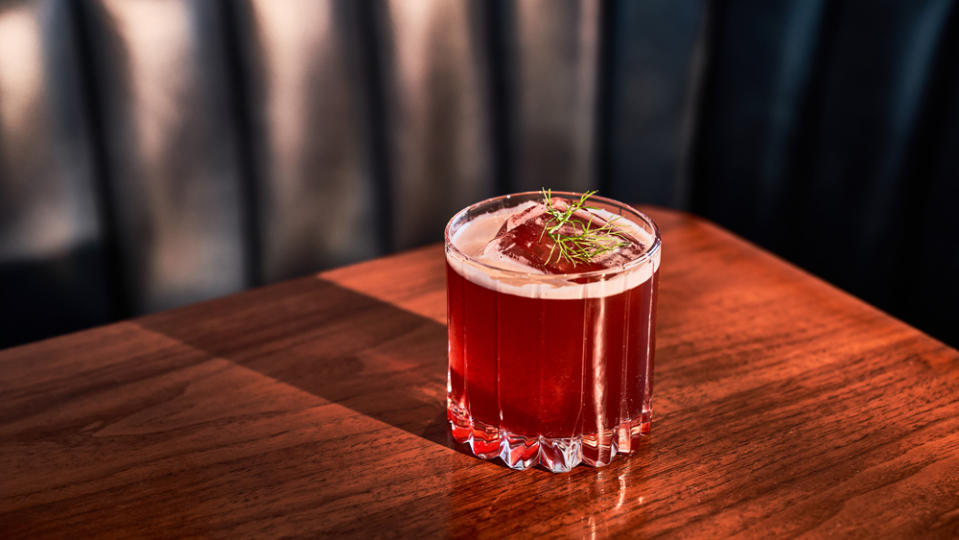Inside Manhatta, the N.Y.C Restaurant With Stunning Views and a Bold New Menu to Match

- Oops!Something went wrong.Please try again later.
When I first visited Manhatta last March, thick, frothy clouds parked outside. There were no views that night from the restaurant’s 60th floor windows, no Empire State Building in the distance to anchor the experience in iconic New York.
No, for the latter, I sat across the bar from Cameron Winkelman who poured me a riff on the Astoria, a reverse Martini named after the hotel (as in Waldorf) and not the Queens neighborhood. Winkelman’s version, concocted during a two-week sprint to Manhatta’s reopening, adds palo santo, absinthe, chrysanthemum, and pickled honeydew to the classic cocktail’s vermouth and gin base.
More from Robb Report
This N.Y.C. Penthouse Just Set the Record for the Priciest Rental in Downtown Manhattan
N.Y.C's Newest Highrises Will Have a Casino and a Soaring Skybridge to Connect Them
I confess, I missed the first iteration of Manhatta, opened in 2018 by Union Square Hospitality. At the time, the restaurant’s forcefield was not potent enough stuff. The city does not lack for bistro-with-a-twist cooking, as it offered, nor do any New Yorkers I know go to dinner to stare out at buildings we already inhabit and light up. (As I write this paragraph, I can see the Central Park Reservoir, George Washington Bridge, and visual blight that is 432 Park Ave.)
But that Astoria alone lured me back to Manhatta—first for more cocktails with friends and, this summer, for dinner—and a full year and a half after the restaurant’s reopening, Manhatta, led by chef Justin Bogle, feels fully ready to flex for New York.
“We’re trying to shake off the cobwebs when it comes to the pre-pandemic notion of what Manhatta was,” says Bogle.

By necessity, the Manhatta relaunch started with Winkelman’s cocktail program. The opening chef backed out at the last minute, and rather than scrambling to roll out a full-service restaurant, USHG focused on the bar. Winkelman, whose résumé includes Mace, Dante, and The Polynesian, created buzz for the space, brought in thirsty guests, and secured a nod as World’s 50 Best Bars “One to Watch.” Winkelman also provided cover as USHG courted Bogle away from Le Coucou, where he had worked as chef de cuisine for six years.
Danny Meyer and Co. succeeded in their bid, giving Bogle the reins to their ode-to-New-York, party-in-the-sky dining room last fall. And, mercifully, rather than bringing classic French cooking back to Manhatta, Bogle has synthesized the modernism of his early days at Gilt with Escoffier-approved technique and the restraint of a mid-career chef.
“New York is so diverse, and after cooking in a box for the past six years, being able to dip into other pantries, styles, and techniques was huge for me,” says Bogle. “Our sauce work is as classic as possible, and we’ve built a deep pantry of fermentations and pickles. Then we have modern techniques, though they aren’t necessarily shoved in your face. The years at Le Coucou helped me pull back and become a little more reserved in that regard.”
On the à la carte menu, that perspective unfolds in dishes like beef tartare with fermented sunchoke and Asian pear and tête de cochon with maple-cured trout roe and peanuts. For his eel and bone marrow, Bogle buys and butchers whole freshwater eels, whose bones get simmered and reduced into a tart glaze and flesh is grilled yakitori-style. Plated with buttery pomme purée and yielding marrow discs, he finishes the dish with a Burgundian, red wine-based sauce meurette. Pastry chef UV Feldman mirrors the new house style with desserts like her chocolate sabayon, salty hazelnut miso ice cream (the team makes the nut miso in house), and tart passion fruit.
In addition to its à la carte menu, Manhatta offers a five-course pre-fixe and a recently launched $275, 10-course tasting menu. The latter, with just 12 seats a night, plays out around the restaurant’s chef’s counter, where most of the seating faces the kitchen—not the skyline—with a view of Bogle’s team hustling to feed some 200 diners a night.

In that rush, and in a flurry of opening bites, cooks still take time to dot curried fresh chickpea tartlets with exactly four tiny white flowers and two mints leaves. Oeufs en gelée get a spoonful of caviar and flutter of chives. Raw bay scallops arrive at the table in a pool of turmeric oil, dusted with za’atar, striped with Meyer lemon rind, and sidled up to a coconut snow (made with liquid nitrogen and a Vitamix, but you don’t need to know that to enjoy the fluffy burst of cold). Bogle builds Manhatta character into steaming, yielding chawanmushi with morsels of charcoal-kissed foie gras cut through with a house-fermented coffee soy sauce made into ponzu with a hit of Sauternes.
“There’s this melding of fine French and fine Japanese cuisines, which you can see throughout the menu,” says Bogle.
In a similar vein, beverage director Will Edwards poured two pairings with the chawanmushi: a 1995 grand cru Château Rieussec sauternes and a Yangchon Chungyu, an umami-forward Korean rice wine. Edwards—an alum of Betony, Carbone, and Gramercy Tavern—inherited an American-focused cellar, also stacked with Burgundies, Riesling, and food-friendly Grüner Veltliner. For the extended tasting, he pulled out a cult favorite bottle of 2016 Comando G La Breña to pair with dry-aged squab, morels, green garlic, and vin jaune. His current favorite duo is a heavy skin contact La Stoppa Ageno orange wine with chile-spiked summer clams.
At the start of the tasting, Feldman sends out baked-to-order pull apart bread with cultured nori butter, and she might wrap the meal with a tart, one-bite mojito mochi and melon-yuzu soufflée or a Madeira sabayon with strawberries and basil oil. Feldman worked at Manhatta in the before times as a pastry cook, when the restaurant mandated a three-course pre-fixe. The new range of options at Manhatta—from à la carte to over-the-top tasting—has given the team more flexibility too, she says.
“Just with the amount of food we were producing pre-Covid, it was 200 guests coming in and 200 desserts. Now, with à la carte, people share desserts or skip it, and we get to do quality over quantity,” she says. “And then the extended tasting for the counter just made everything feel special.”

Manhatta walks a very fine line of being a restaurant for everyone, for all occasions.
There’s still a burger on the bar menu (albeit an exceptional dry age number), and tourists can still gobble up the views. Diners paying $275 for 10 courses of fireworks sit between a busy cocktail bar and made-for-anniversaries dining room. The last New York restaurant to excel at the format was Betony (RIP), where you could plop down at the bar for tempura vegetables and too many milk punches or have a coursed-out dinner with Coravin-portioned pairings. Business travelers mingled with rowdy-ish bar flies. With its current, ambitious team, Manhatta may well be Betony’s downtown successor, just with a firm foundation USHG-style service.
“One of the most important things with the team and why we’ve been so successful is that very natural, amazing hospitality,” says Winkelman. “It doesn’t matter who you sit in front of at the bar or on what days, you’re still going to have a really good experience.”
Still, service only gets you so far. The warm-fuzzies alone do not inspire butts in seats, even ones in prime Manhattan real estate. And Manhatta’s current team is cooking, serving, and bartending like they have something to prove. “It’s a matter of pushing,” says Bogle. “Pushing the menus, pushing young sous chefs to start being creative, pushing boundaries with the extended tasting. We’re 10 months in, and we want people to know we’re here.”
When Winkelman took the job, the powers at USHG asked him to create a menu of classic cocktails named after New York neighborhoods: the Brooklyn, Bronx, Manhattan, Red Hook, etc. “Which is a cool idea and concept,” he says, “but it was pretty hard to execute, because all those cocktails suck. There’s a reason no one’s going to bars and ordering Brooklyns. It was a really cool challenge to turn those drinks into dope cocktails.”

He turned the Little Italy into a highball (and a nod to Chinatown’s expansion) with pandan-infused rye, Carpano Antica, Cynar, and Chinotto. For the Red Hook, Winkelman washes rye with toasted coconut and stirs in bittersweet Punt e Mes, maraschino liqueur, and chocolate bitters. Then, of course, there’s his Astoria.
Beyond those signature drinks, Manhatta serves a rotation of seasonal cocktails, anchored by Winkelman’s inconspicuously culinary, high-tech style. Now that he’s gunning for an official spot on the World’s 50 Best List, he admits, his approach has grown more intense. The Body Language, for example, takes on a refreshing Paloma build, but the tequila is fat-washed with white cacao. He adds in ume plum, and the lime juice is spun through a centrifuge. Using a technique he learned from Singapore’s Jigger and Pony, Winkelman made a bright pink, clarified grapefruit juice-agar-gelatin disc for a garnish.
“It follows the ethos of everything we want to do,” Winkelman says. “I had very little time to make the initial menu. And, now, with each drink, I want to make sure that it’s not only as good as anything on the permanent menu, but that it’s also pushing it a little further.”
Click here for more images of Manhatta.
Best of Robb Report
Why a Heritage Turkey Is the Best Thanksgiving Bird—and How to Get One
The 10 Best Wines to Pair With Steak, From Cabernet to Malbec
Sign up for Robb Report's Newsletter. For the latest news, follow us on Facebook, Twitter, and Instagram.


